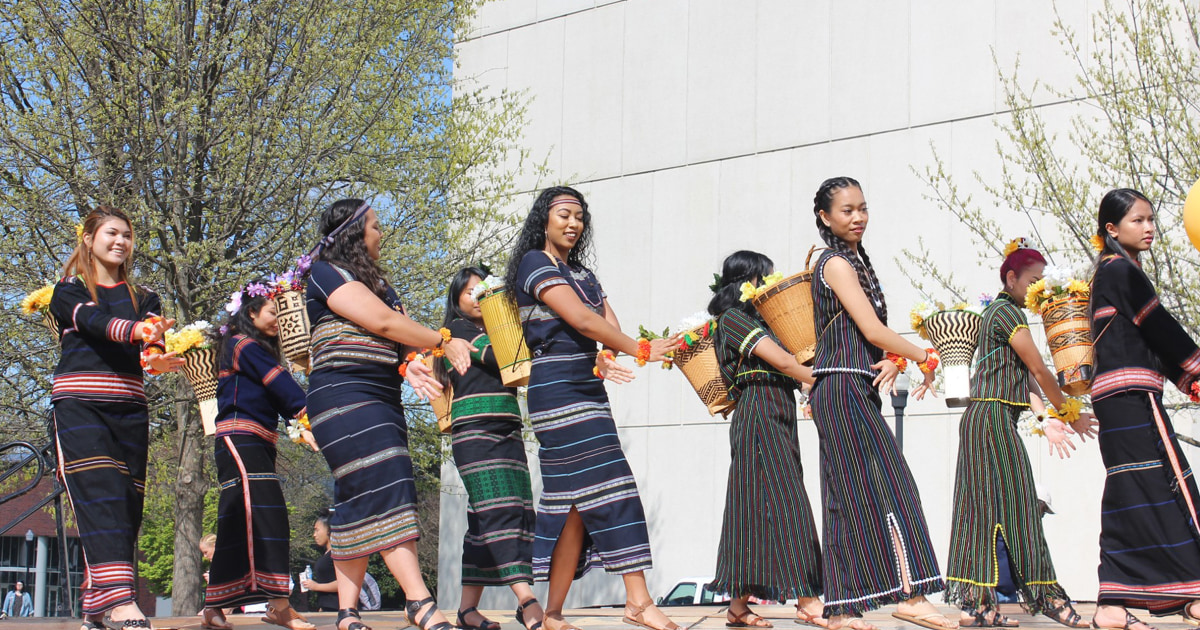
After immigrating to the U.S. at age 9, Hthu Nie spent years denying who she was. Nie, who is Montagnard, an ethnic minority indigenous to Vietnam’s central highlands, told her classmates she was Vietnamese, not trusting they’d grasp the nuances between the two. “I was like, ‘I’m in America now,’” she said. “I didn’t think it was such a big deal.” It was only when she entered college that she began to question why she was “erasing [her] own culture.”
Nie, who graduated in 2021 and will start nursing school in the fall, has become an outspoken proponent for the preservation of Montagnard customs and traditions. Like many Montagnards her age, she feels a profound sense of urgency as heir to a “dying culture,” the survival of which she believes falls on her generation’s shoulders.
These young leaders have made it their mission to ensure their heritage — rooted in persecution due to their alliance with the U.S. during the Vietnam War — is passed on.
Across social media, their efforts are evident.
In one TikTok video, three friends dance in handwoven embroidered clothing for the #cultureoutfitchallenge. Set to the viral chords of Jawsh 685’s “Laxed,” they each take a turn to theatrically sway for the camera.
On Facebook, the nearly 1,500 members of the private group Montagnard Food share cooking videos and post images of classic dishes, such as Trong Phi (bitter eggplant) and beef salad. “We love our foods,” one poster wrote above a photo gallery of traditional cuisine.
Artists, such as Sachi Dely, create work blending history with their life experience in the U.S. Others, like Nie, are pursuing careers that will allow them to directly serve the community.
Since the first refugees arrived in 1986, North Carolina became home to the largest number of Montagnards outside Southeast Asia, with a population that has swelled to over 12,000, most living in the Piedmont Triad area.
Despite this growth, the preservation of Montagnard culture has become harder over the years, in part because of assimilation. And the particulars of the Montagnards’ history mean that their culture isn’t necessarily being safeguarded in Vietnam either — putting their identity truly at risk.
Montagnard, which means “Mountain People” in French, is an umbrella term for more than 30 tribes that originally inhabited what is today Vietnam. Ethnically distinct from the country’s Kinh majority, who are predominantly Christian, they’ve been discriminated against for over two centuries. However, it was their fighting alongside the U.S. Special Forces during the Vietnam War — in the hopes of gaining autonomy — that led to their continuing large-scale victimization at the hands of the central government.
After the U.S. pulled out of the war, the Montagnards were targeted as “traitors” and put in re-education camps as the Communist Party sought revenge. Large numbers fled to the U.S. and Cambodia and, as has been documented by human right organizations, the 1 million that remain in Vietnam continue to be subjected to abuses that include religious persecution, land seizure, imprisonment and forced assimilation.
In 2015, the Montagnard Dega Association (MDA), the Greensboro-based service provider at the center of American Montagnard life, formed a youth branch, with a focus on education and cultural heritage. Offering classes in traditional music, dance and weaving, the Montagnard American Organization (MAO) works to instill the value of Montagnard cultural practices in youth of all ages and involve them in civic life.
Liana Adrong, executive director of the MDA, has noticed that young Montagnard adults have an increased interest in their culture. This is likely in part due to years of the organization’s influence as well as the current ability to share and learn through social media. “The age group in their early and late 20s now are wanting to learn about their culture, about their language,” she said.
According to her, language is integral to any cultural preservation effort. “Without language, without being able to speak, it is hard to find out who we are and then to learn about ourselves.”
Dely agrees. It wasn’t until the late 19th century that French missionaries created an alphabet for the dialects corresponding to each tribe, and the Montagnards have a strong oral tradition. “[In the past], things weren’t being written down, but told through stories,” she said. “I would like the stories to be passed down because they tell so much about who we are as a people and what our tribes did.”
However, keeping Montagnard languages — and stories — alive, at least in their current form, may be a challenge for the younger generation. Parents are often hesitant to speak their native tongue to their American-born children, and though the MDA tries to offer classes, there are few people qualified to teach the languages and a scarcity of materials to use for instruction. Even in Vietnam, where all schools are taught in Vietnamese, the only material used to teach the Montagnard languages is the Bible.
The key to cultural preservation for the Montagnards may come down to recognizing older traditions giving way to modern forms.
Social media is a big part of this, but so is language. In 2019, members of the MOA collectively translated a Vietnamese folktale, “Why Ducks Sleep on One Leg,” into the Rhade and Koho dialects for younger children, with the English printed alongside it.
B&K 2K19, a clothing label owned by two Montagnard sisters, offers both traditional pieces and modern versions of them.
Last year, the MDA funded “The Past is Present: New Montagnard Artists,” a gallery exhibition and two-day event in which practitioners of traditional crafts, such as backstrap weaving and basketry, were paired with younger artists to create works in new mediums. The show was meant to not only promote Montagnard artists and culture, but, as Dely, who participated, explained, to demonstrate that as a refugee community “things that happened to [the Montagnards] a long time ago still affect our generation.”
Although the Montagnards’ struggles and their relationship to the United States are unique, Adrong sees a similarity between the Montagnards and other immigrant and diasporic populations. “I wonder if other Asian American communities are going through the same thing in terms of generation gap and trying to preserve their culture,” she said, adding, [cultural preservation] “starts in the home.”
Source: | This article originally belongs to Nbcnews.com









